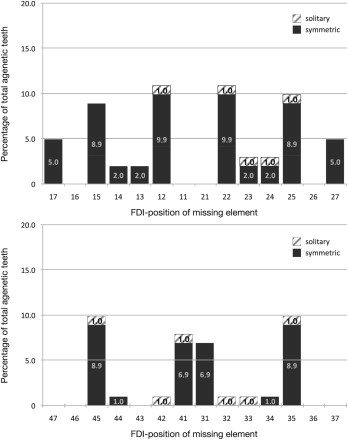Introduction
The purposes of this study were to investigate the patterns of tooth agenesis (oligodontia and nonoligodontia), maxillary canine impaction, and tooth transposition in subjects with Down syndrome and to determine whether congenital heart disease and hypothyroidism are parameters in tooth agenesis.
Methods
The study included 114 patients with Down syndrome. The data were quantified by using standardized records, clinical examinations, panoramic radiographs, and solo roentgenograms. The subjects were differentiated into oligodontia (6 or more teeth missing) and nonoligodontia (5 or fewer teeth missing).
Results
In these patients with Down syndrome, 59.6% had missing teeth. Those in the nonoligodontia group showed a tendency toward a negative correlation between congenital heart disease and agenesis ( P = 0.093; odds ratio = 0.49) but a slight positive correlation between hypothyroidism and agenesis ( P = 0.060; odds ratio = 3.71). In the oligodontia group, there was a quantitatively and qualitatively different pattern, indicating another phenotype. When both mandibular central incisors were missing, there was a remarkable chance for oligodontia ( P = 0.001; odds ratio = 38.8). In the mandible, symmetrical agenesis of the canines and lateral incisors was more frequent in the nonoligodontia group.
Conclusions
The oligodontia (with a different phenotype) and nonoligodontia groups had different patterns of agenesis. Maxillary canine impaction was not related to absence of the lateral incisors. Absence of both mandibular central incisors was a high predictor for oligodontia. Congenital heart disease and hypothyroidism are parameters involved in tooth agenesis.
Editor’s comment
Hypodontia in patients with Down syndrome (DS) has been studied extensively. Nevertheless, greater knowledge of treatment planning for those with hypodontia and, more specifically, oligodontia, is needed. Oligodontia is the congenital absence of 6 or more permanent teeth, excluding the third molars. Recently, mouse models have shown that the DS critical region (DSCR1) on chromosome 21 does not cause craniofacial or cardiac anomalies; the occurrence of these conditions is increased by trisomy 21 only indirectly. Perhaps a threshold effect of total transcript and protein level must be reached for certain DS-related phenotypes to appear. Considering the various forms of phenotypes with different signs and symptoms, these researchers sought to link genetic trisomy 21 and its particular DSCR1 to several other parameters, including dental agenesis and impaction as well as congenital heart defects and thyroxine deficiency. In conducting this study, the authors took advantage of an extensive data collection and references to describe their various clinical findings.
The final sample included 114 subjects with DS, 9.5 to 23.9 years old, who were referred to the Centre for Special Care Dentistry in Rotterdam by general practitioners. The authors were quick to note that this study had a very specific patient group, and, because of this limitation, a sample size with ample statistical power could not be realized.
The investigators found that several parameters contribute to the prevalence of tooth agenesis. This finding will help to improve decision making and treatment planning for a young child with DS, and it is hoped this will provide lifelong benefits. Guiding impacted teeth to the right positions might prevent malocclusion and lead to optimal bone height. This guidance might involve regular roentgen screening to assess the stages of eruption and development of teeth, which are often delayed. Important for orthodontic treatment is that stature growth is slowed during childhood, the adolescent period is shorter, and the maturation of bones takes place around 15 to 17 years of age in a patient with DS. Among several findings, oligodontia in children with DS defines a subgroup with a different phenotype. This group is 81 times more likely to suffer from oligodontia than is the normal population. In planning future research, the first step in this area of concern would be to precisely document the onset of hypothyroidism, the doses of medication, and the teeth that are affected.





